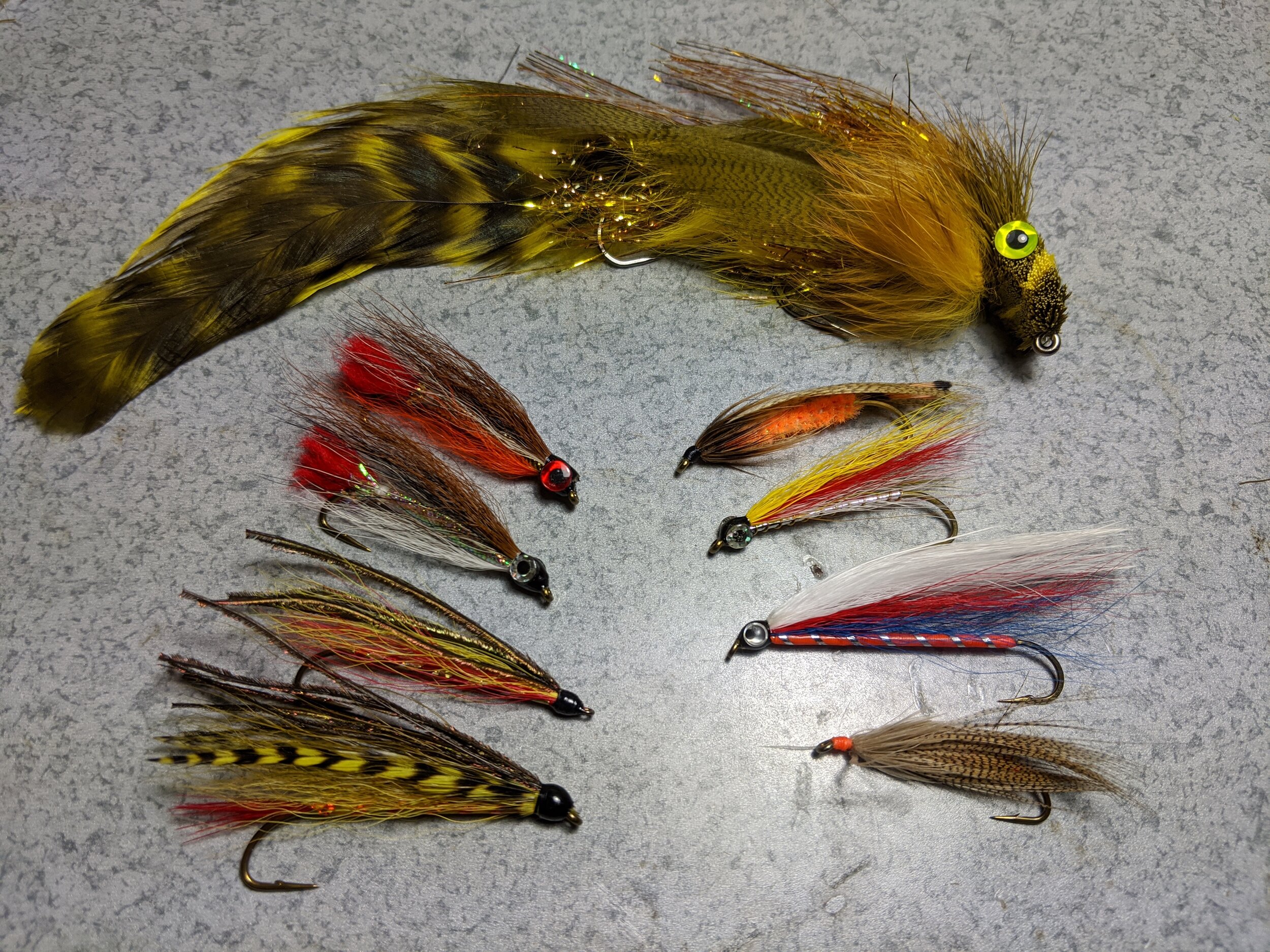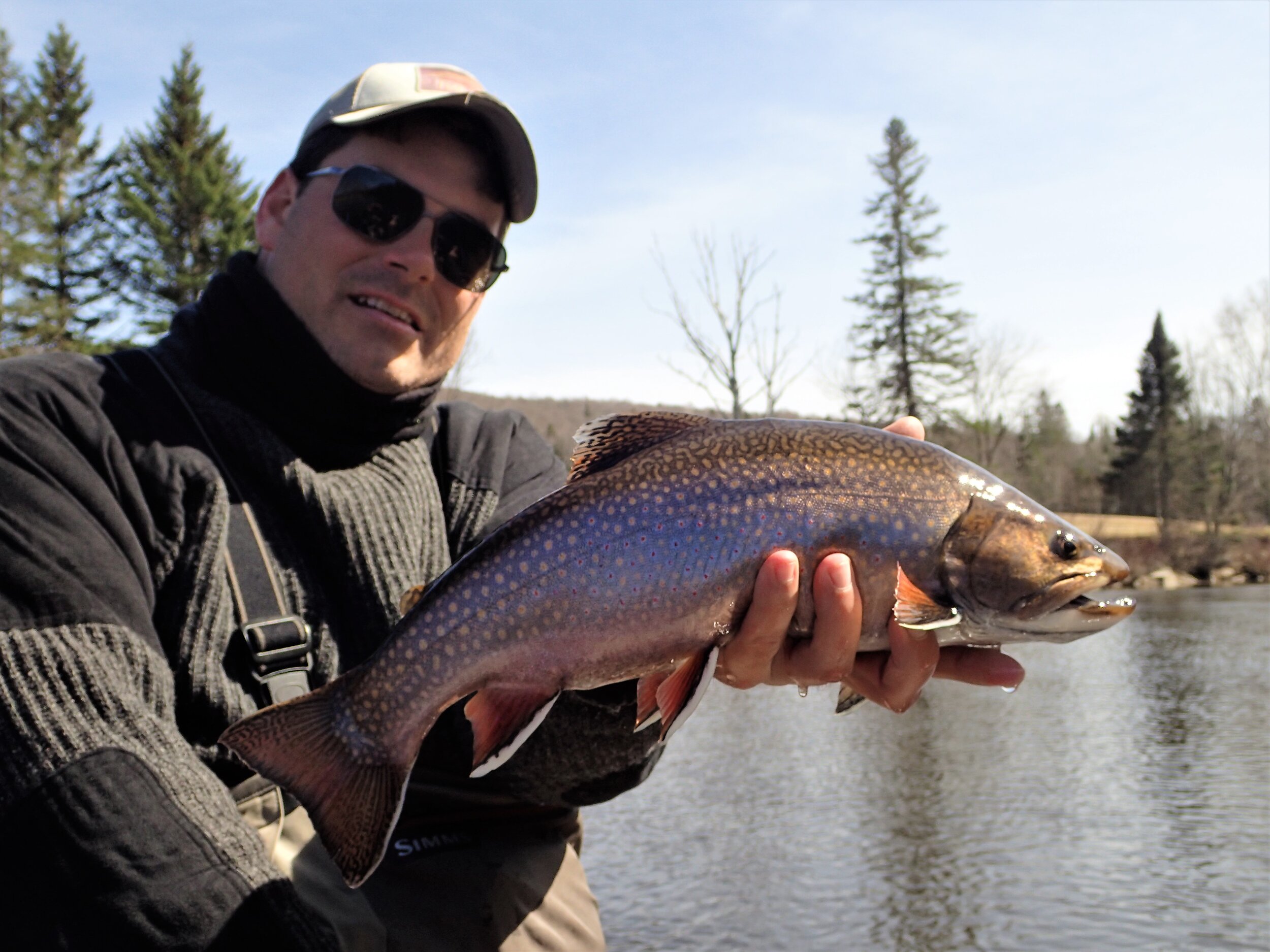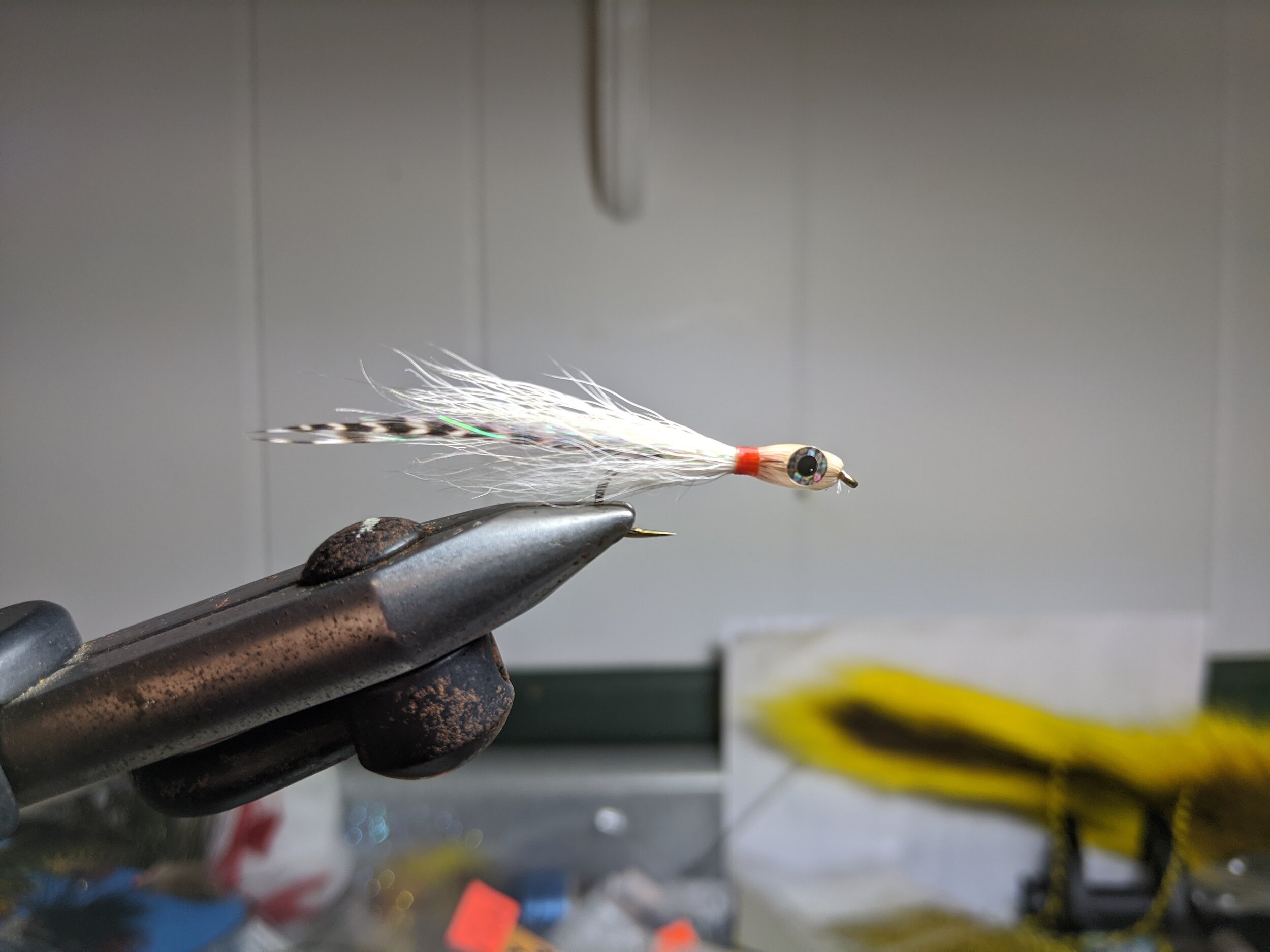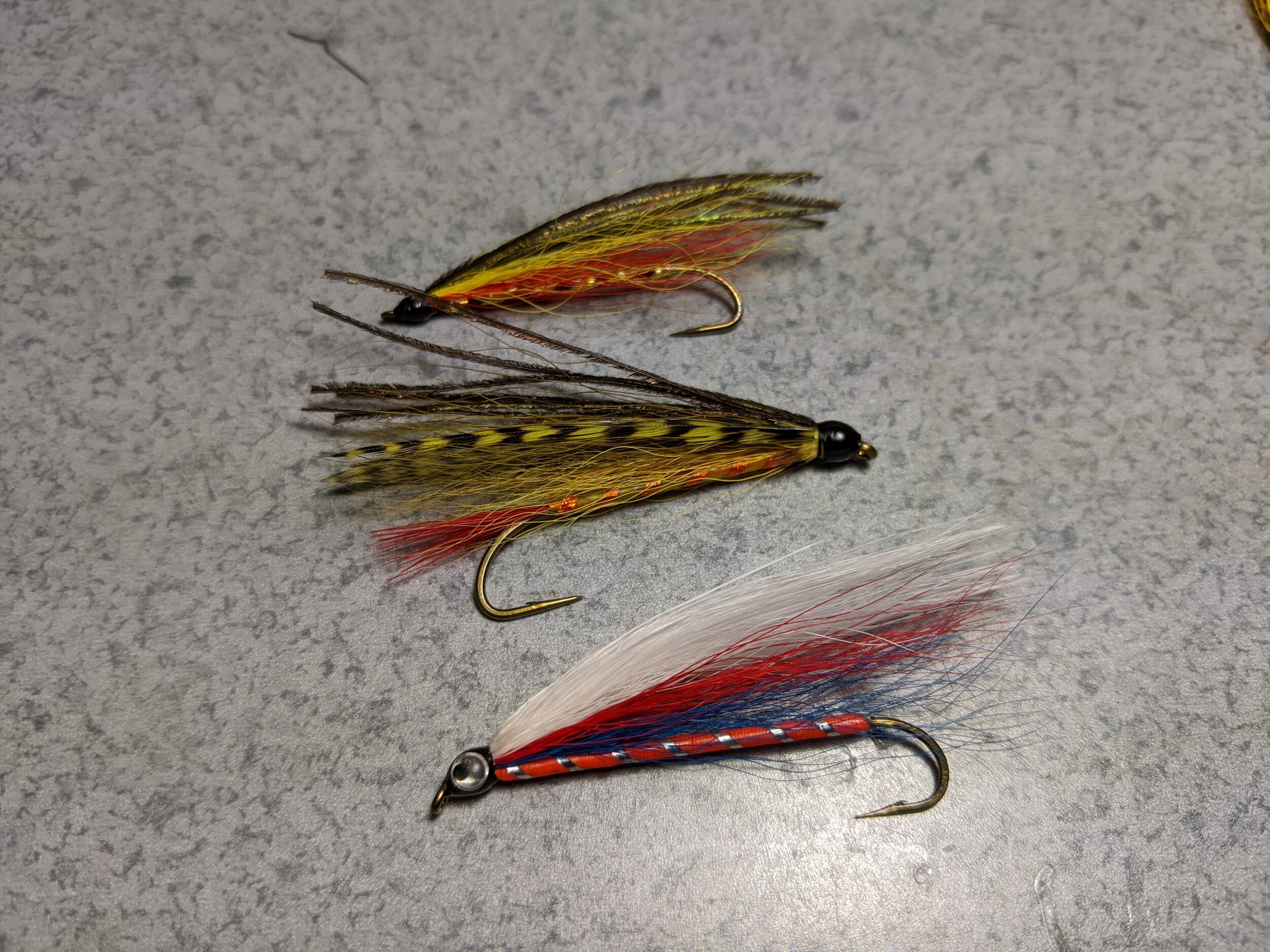In a world of “Modern Streamers”, can we still find a place for traditional patterns?
I’ve been obsessed with streamer flies and fishing them for as long as I can remember. I am fortunate that my father is a lifelong fly fishing addict, and he started me in the sport at a very young age. He began taking me away on his annual “ice-out” trip to Northern Maine when I was only eight years old. Traditional Maine streamer flies like the Grey Ghost, Black Ghost and Magog Smelt were common selections as we trolled and cast for Spring landlocked salmon, brookies, and togue (lake trout). Something about those colorful flies and that powerful tug when a fish took always stayed with me. Closer to home, those same flies often found their way onto the end of my line when fishing my local trout waters in Northern New Hampshire.
Like all young anglers, I became obsessed with the idea of catching the biggest fish possible as often as possible. Streamers produced most of my largest fish when I was young, and as a result I probably spent more time fishing them than I realistically should have been. Instead of becoming a more well rounded fly angler, I swung and stripped streamers looking for any big fish I could find, and often I ended up empty handed. When I couldn’t find success with flies, my solution was to turn to conventional gear and tackle. I spent a good portion of my younger days casting lures and spoons, and produce they certainly did. I was always impressed with the ability of a Rapala to attract big trout on days when nothing else seemed to work.
I could have remained a gear angler, but there was always something so appealing about fly fishing to me. As I got older, I realized that in order to consistently catch fish, I had to become a more complete angler. I became a better dry fly fisherman and learned to nymph and began to understand when to use what techniques, and eventually my spinning rods went permanently into the closet. But a part of me was still obsessed with the idea of throwing streamers to find big trout. I realized that the traditional flies of my youth had limitations, and if I wanted to match the success of the Rapala with a fly, I needed bigger, badder fly patterns.
Magazines and the Internet introduced me to the innovative patterns and ideas of anglers like Jack Gartside, Bob Linsenman and Kelly Galloup. These anglers were pioneers of a modern streamer revolution through the 90’s and early 2000’s. Quickly my classic streamer patterns were replaced with large #2 and #4 wooly buggers, marabou muddlers, soft-hackle streamers and then later larger imitations tied of rabbit strips, gradually evolving into monstrous articulated streamer patterns tied of every conceivable material. Gone was my old leather fly wallet with a few crumpled bucktails, replaced with boxes, some the size of a briefcase.
So then what about the classic streamer fly? Has the modern streamer eliminated the usefulness of classic patterns that caught trout and salmon for more than 100 years?
Not a chance. If I have ever learned one lesson from fishing, it’s that in order to consistently be successful, an angler must be well rounded and use every tool at his or her disposal. You never know what kind of conditions you will face on the water, and having a variety of fly patterns and styles will help you to meet the challenges of each day on the water. What follows are some of my observations and ideas of where traditional flies still fit into a modern streamer system, learned from years of fishing and being a professional fishing guide….
A key to angler success is developing systems to make oneself efficient and effective on the water. No one fly will magically produce day in and day out on the water. A key to being successful with streamers is carrying a variety of patterns to cover a variety of conditions. Classic streamer patterns can be an effective tool within a well-rounded streamer system.
So where do classic streamer patterns fit into today’s world of “Modern Streamers”?
As a fishing guide, I don’t get to pick and choose the days I guide. I go when I’m booked. In addition, I don’t often get the luxury of choosing prime days to go fishing when I’m not working. I get out when I can get out. Whether guiding or fishing on my own, I need to have flies and techniques to deal with whatever conditions I find. To maximize success, anglers should develop systems for choosing techniques and flies based on conditions. In streamer fishing, this means looking past the “big fly = big fish” mentality.
The revolution in streamer fishing of the last 20 years has caught on in a big way. Modern fly design and techniques has produced fly patterns and fishing techniques that more consistently produce big fish on pressured fisheries than the fly patterns of old. For a time, fly design became a nuclear arms race. Everyone seemed to be trying to produce something bigger and with more movement than the other guys fly. Most of the really good fly designers and fishermen eventually realized that there is a law of diminishing returns in streamer fishing for trout. Eventually your fly just gets too big to really be effective on the water. More recent years has seen the introduction of the “Mini” articulated fly. Now we have “Mini”-Game Changers, “Mini” Sex Dungeouns and “Mini” Boogeymen. These flies range in the 2 to 4 inch category, and probably are about as close to the perfect weapon going in streamer fishing today.
As good as all these modern flies are, there still is no magic fly among them. Big flies, small flies, they all work…provided you fish them under the proper conditions. Good streamer conditions for trout are generally associated with low light or cloudy days, and elevated water flows or diminished water clarity. Combine all these conditions, and trout will actively seek larger prey items, and the modern streamer is your best weapon. But change one of those elements, and suddenly those big articulated flies stop pulling fish from everywhere. What can you do when you are faced with low, clear water, bright sun, and heavily pressured fish? This is where having a well rounded system of streamer pattern selection in place can really help you. We’ve all been there. It’s bright, there’s no hatch, the nymph fishing sucks, and slapping the 4 inch bunny strip on the water feels like you’re throwing rocks at the fish. This is when something a little more traditional might just save your butt…
Thoughts on Fly Patterns:
The key advantage with traditional streamers really boils down to size, profile and weight. Classic flies tied from natural materials can offer realistic looking imitations of forage in small sizes that can be presented delicately to wary fish. They also can be tied in offensive attractor colors as well, but aren’t so large and offensive to put pressured fish off. I favor traditional patterns like bucktail and marabou baitfish streamer patterns, small wooly buggers, and muddler minnow variations.
Rods/Lines:
Generally, classic flies come out during low water conditions and when I’m on foot. You really don’t need the 7 or 8 weight and 250 grain sinktip for this style of fishing. The exception is when drifting and I want to fish double streamer setups. Classic flies like bucktails, thundercreeks, and wooly buggers make great trailer flies, and this is the one instance when I fish them on heavier setups, but this is always in conjunction with a much larger modern streamer.
When I’m guiding, I generally carry a 6 weight rod with a 150 or 200 grain sinktip rigged and ready to go for clients when I want them to throw streamers. Likewise, when I’m fishing on foot and I know I will be primarily throwing streamers, I’m fishing the same 6 weight setup. In stillwater situations, I also fish streamers on a 6 weight, but carry multiple sinking lines for fishing different depths.
Most days when I’m wade fishing, I generally expect to fish a variety of tactics. I don’t like to carry multiple rods, so generally I’m fishing a 9 foot 5 weight with a floating line which allows me to effectively fish dry flies, nymphs and streamers. I used to carry a second spool with a light sinktip that I would swap to fish streamers. Recently, I had an opportunity to guide a very skilled angler from Europe who introduced me to the idea of sinking poly-leaders. I now carry a variety of sinking leaders, some short, some long and in different sink-rates, that I swap out depending on conditions or situations I encounter on the water. This setup has been a revelation for me, and one I recommend every serious streamer fisherman add to their arsenal.
Times when classic flies can shine:
Smelt Run
A landlocked salmon favored a traditional smelt imitation on a sunny day. No “modern” streamer design could produce a fish this day, but the traditional design produced several quality salmon and lake trout.
Every Spring starting sometime between mid-April and early-May, smelt populations in our Northeast lakes begin their annual spawning runs up tributaries. This is the first major chance for many of our trout and salmon to put on the feedbag following winter, and this is a great time to catch big fish on streamer imitations. Indeed many of my largest fish have been caught at this time of the year. These days, most of my best patterns are tied from rabbit strips or synthetics. These flies work really well…most of the time. During years when the smelt run is heavy, fish feed greedily the first few days of the run, and then become stuffed and lethargic. Popular fishing spots also see fish become pressured and shy. Combine these elements with sunny days, and great fishing can turn tough in a hurry. This is when turning to traditional, smaller, sparse imitations tied with bucktail and marabou can really help. Something about a sparse fly with a natural profile and natural materials seems to be able to fool picky fish better than the bunny and synthetics. My father still favors a classic imitation of mylar and marabou that I tie for him, and he routinely kicks my butt on slow days while I flail away with my modern flies.
Stillwater Baitfish Spawn
A stout stillwater brook trout was coughing up 4 inch baitfish, but still took a 2 inch wooly bugger.
Following the smelt run, other minnow species follow suit. Local rivers see the White Sucker spawn, and this has become the main event of the season for many people. Hordes of anglers flock to our local streams armed with their bobbers and egg patterns, to stand shoulder to shoulder with each other. These anglers completely forget that the same thing is happening on our local ponds and lakes, and miss out on some of the best stillwater fishing of the season.
Spring stillwater favorites. A traditional “red tag” bucktail and a Wood Special. Deadly imitations of spawning Red-Belly Dace. Alter the colors a little and they are a great match for a variety of forage species.
Each Spring, clouds of baitfish crowd the shallows of ponds and lakes in big spawning schools, and trout eagerly gobble up as many as they can. Stillwater streamer fishing is where the classic streamer really shines. I really prefer bucktail imitations, as they offer a realistic profile with no weight. Fish them on a light sinking line or clear intermediate, and you can hover and twitch your lightweight streamer in inches deep water. Often you can land the fly just off the shore, and a couple of quick twitches towards the drop off and your fly will get crushed by a huge trout waiting to ambush an unsuspecting school of bait. I’ve fished a lot of different styles of streamers in stillwater, and I still can’t find anything better than traditional bucktails and wooly buggers, especially for fishing shallow water.
Run-off Streamer Fishing
A small Thundercreek bucktail makes a nice fry imitation. They look natural, don’t “foul”, and take 2 minutes to tie. It’s worth carrying a few.
Every Spring our rivers swell with snowmelt and rain. Small trout and salmon fry that hatched out in early Spring, along with young of the year baitfish get swept out of their natal habitats by the high water and become easy pickings for big, hungry fish. As the high, cold, muddy water begins to subside, some of the best streamer fishing of the year occurs. This is one of the best times of the year to fool the biggest fish with your biggest flies. But sometimes the conditions don’t line up, and the big flies draw follows, but no eats. This is a great time to think about a double streamer setup. Small flies trailed off the back of large streamers are often the recipe for success. Big fish will notice the large fly, but choose to eat the smaller offering. Wooly buggers are a popular choice, but I also favor bucktails and especially thundercreek-style flies. These simple flies make very realistic fry and parr imitations, and the design of the fly reduces “fouling”. You spend more time fishing and less time “un-fouling” tangled tails. It’s worth keeping a few in your wade and boat boxes.
Summer Time Trout
A beautiful, wild, freestone brown trout fell to a small streamer twitched around structure in the summer in very low water. Will these classic flies produce a 26 inch monster? Probably not…but they keep you catching fish when other techniques aren’t working.
Summer means lower flows, bright sun and an ending to midday hatch activity. As anglers, we tend to switch to fishing early and late to be successful. On bigger waters, larger streamer flies can still produce results in low-light, but in crystal-clear freestone streams, any kind of big splash sends spooky trout running for miles. Again, this is where I reach for something a little smaller and more subtle. Small natural-colored muddlers, buggers, and baitfish imitations presented delicately on light lines land naturally on the water and reduce spooking. Fished on light sinking leaders or sinktips, these unweighted flies can be twitched and hovered tight to structure where fish will be hiding, and this can be key to drawing strikes in the daytime. Recently, Michigan streamer guru and fishing guide, Alex Lafkas launched a YouTube channel to discuss a variety of topics related to streamer fishing. I admit I had a big smile on my face when he revealed that a simple Black Ghost was one of his go to low water streamers on his crystal-clear, pressured Michigan rivers. Alex might be the best in the streamer business, so this is a pretty glowing endorsement of how effective these flies can be.
Fall Fishing
Fall has long been synonymous with streamer fishing. Colorful imitations tied to anger colorful pre-spawn brook trout is really what gave birth to streamer fishing. The same ideas were applied to fall brown trout and streamer fishing gained a cult following.
Fall trout are territorial. Imitations of smaller trout can be key in enticing a big fish to strike, and are good options under any conditions. But be warned, as brighter flies will fail you if fish have been sitting in one place for any length of time.
The mistake that most anglers make is in thinking that Fall is all about big flies. In fact, it can be quite the opposite. Fall often sees some of the lowest flows of the season and some of the most beautiful blue-sky weather a person could ever hope for. Migrating, pre-spawn fish will aggressively take big flies under ideal streamer conditions. But bright sunny days can often mean resting fish, that can be downright impossible to move on any fly.
Every Fall, my clients arrive and eagerly show me the giant articulated monstrosities that “so n’ so” at Bean’s or Orvis or wherever told them they had to have to catch the biggest brook or brown trout of their life. I smile and tell them that it is a good choice, but it hasn’t rained in a month and we are expecting low water and sun for a week straight. I humor them and let them splat the big fly around on the flat, clear pools for awhile, but after an hour of no action I usually politely suggest we try something a little smaller.
Low water Fall fishing is much like summer streamer fishing. Small imitations presented delicately on light lines can be the key to success. Fish that are on spawning runs can be susceptible to attractors when they first settle into a resting pool or run, but after a day or so in clear conditions they seem to ignore brighter options. Natural looking food items, with tiny hints of color that can be twitched and kept close to resting fish is often what will produce best. There are many classic time proven streamer imitations for fall brookies and browns that are worth trying if you find yourself stuck with bright days and low clear water.
A word of warning:
While I encourage anglers to keep a few classic streamer flies in their rotation, I must offer a word of warning in regards to their weakness. Especially in regards to bucktail and marabou streamers.
I fish all barbless hooks. Many of my local waters mandate this, but I feel any angler not seeking to keep their catch should fish barbless. We owe the fish to do the least damage as possible. The downfall of traditional “Rangeley” style streamers is that they are typically tied on hooks that have extra long shanks, and narrow hook gaps. When these style of hooks are de-barbed, they struggle to hold fish. The long shank and narrow gap have a “crowbar” effect, and fish can leverage themselves free more easily than on other hook styles. Care needs to be taken to maintain solid pressure while fighting fish, and low rod angles should be utilized to prevent fish from jumping.
I’ve been fortunate enough that I have caught some very nice fish in my life, and as such I don’t get too broken up if a nice fish comes unhooked….I was going to let it go anyways. But if you really worry about losing big fish and your Instagram fame, I caution you with these flies. Always crush your barbs, and if you worry about losing fish, try tying these same patterns of shorter shanked hooks. I still prefer the classic hooks, as they make for a nicer looking fly, and feel that shorter hooks make these flies heavier and defeat their lightweight advantage. But feel free to experiment, that’s half the fun!
Final Thoughts:
Modern streamer design has produced some truly epic fly patterns. But all patterns have limitations. A successful angler should try to incorporate as many tools into his or her toolbox as possible. Traditional streamers over the course of a season will fall well short of matching up with more modern flies, but they can be useful at times, and help produce when other flies and techniques fail. These days on the river it seems that everyone I see walk by with a streamer setup has a fly that looks more like a grey-squirrel than a minnow, so it might a good idea to have a few options to show fish that are getting used to seeing the articulated monstrosities. Hopefully you will consider leaving a few slots in the streamer box for some old-school flies. You might be surprised how effective these flies can be for you. Good luck.








